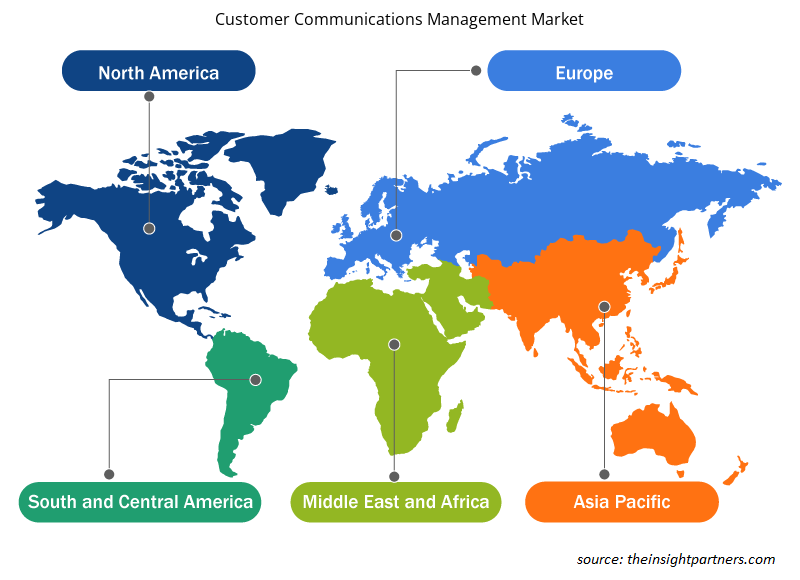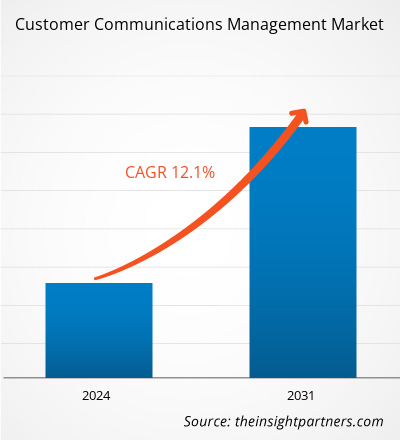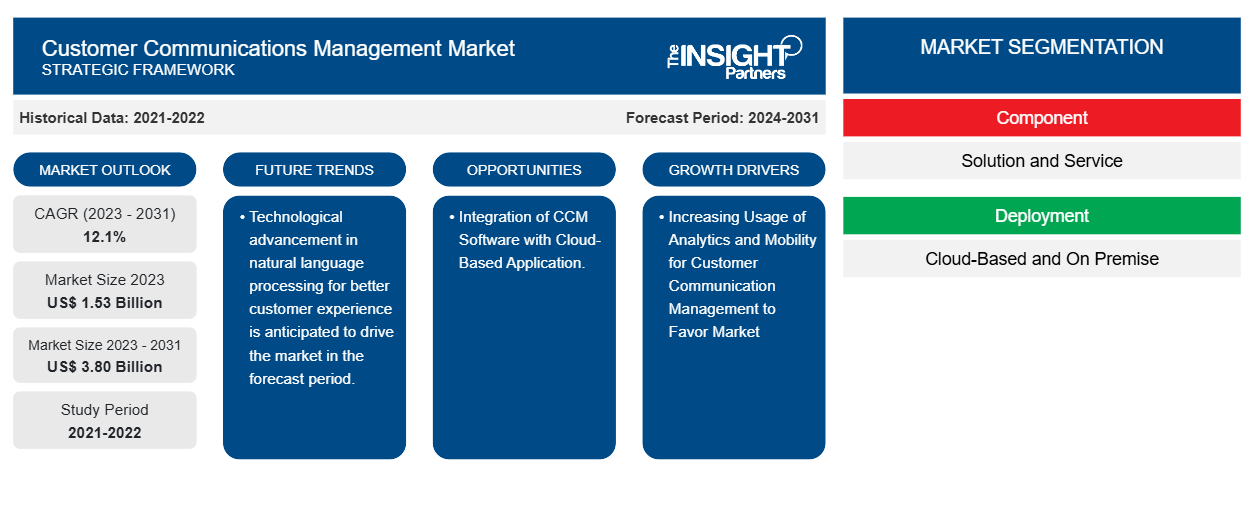Der Markt für Kundenkommunikationsmanagement soll von 1,53 Milliarden US-Dollar im Jahr 2023 auf 3,80 Milliarden US-Dollar im Jahr 2031 anwachsen. Für den Zeitraum 2023–2031 wird ein durchschnittliches jährliches Wachstum von 12,1 % erwartet. Lösungen für das Kundenkommunikationsmanagement ( CCM ), die die Kundenbindung über Omnichannel aufrechterhalten, werden voraussichtlich weiterhin wichtige Trends und Treiber auf dem Markt bleiben.
Kundenkommunikationsmanagement-Marktanalyse
Der Markt für Kundenkommunikationsmanagement verzeichnet ein starkes Wachstum. Dieses Wachstum ist auf Kundenkommunikationsmanagementlösungen, die Aufrechterhaltung der Kundenbindung über Omnichannel und die zunehmende Nutzung von Analyse- und Mobilitätstechnologien für das Kundenkommunikationsmanagement zurückzuführen.
Marktübersicht zum Kundenkommunikationsmanagement
Mitteilungen wie eine Rechnung vom Stromversorger oder eine Kreditkartenabrechnung von der Bank scheinen einfach zu sein. In Wirklichkeit sind sie jedoch komplex in der Gestaltung und Übermittlung. Sie enthalten zahlreiche Funktionen, wie etwa Kundendaten aus einem Customer-Relationship-Management-System ( CRM ), Marketingbotschaften aus einer Marketingplattform, Finanzinformationen aus einem Enterprise-Resource-Planning-System ( ERP ), Markenwerte aus einer Digital- Asset -Management-Plattform (DAM), Geschäftsbedingungen aus einem Rechtssystem und mehr.
Passen Sie diesen Bericht Ihren Anforderungen an
Sie erhalten kostenlos individuelle Anpassungen an jedem Bericht, einschließlich Teilen dieses Berichts oder einer Analyse auf Länderebene, eines Excel-Datenpakets sowie tolle Angebote und Rabatte für Start-ups und Universitäten.
-
Holen Sie sich die wichtigsten Markttrends aus diesem Bericht.Dieses KOSTENLOSE Beispiel umfasst eine Datenanalyse von Markttrends bis hin zu Schätzungen und Prognosen.
Treiber und Chancen auf dem Markt für Kundenkommunikationsmanagement
Zunehmende Nutzung von Analytik und Mobilität für das Kundenkommunikationsmanagement begünstigt den Markt
Datenanalyse ist der Prozess des Sammelns, Verarbeitens und Analysierens von Daten, um Erkenntnisse zu gewinnen und Entscheidungen zu treffen. Datenanalyse kann effektive Möglichkeiten bieten, mit Kunden mit eingeschränkter Mobilität zu kommunizieren und zu interagieren. Zu diesen Möglichkeiten gehören das Erstellen von Inhalten und Schnittstellen, die zugänglich und nutzbar sind, das Personalisieren und Anpassen von Produkten und Dienstleistungen auf der Grundlage von Kundendaten, das Repräsentieren von Kunden mit eingeschränkter Mobilität in Marketingkampagnen und das Aufbauen von Vertrauen und Empathie mit ihnen. Daher treibt die zunehmende Nutzung von Analysen und Mobilität für das Kundenkommunikationsmanagement den Markt für Kundenkommunikationsmanagement an.
Integration von CCM -Software mit Cloud-basierter Anwendung.
In den letzten Jahren hat sich aufgrund des technologischen Fortschritts und der sich ändernden Kundenerwartungen und Geschäftsanforderungen (Communications-as-a-Service, CaaS ) die Wettbewerbslandschaft rasch verfestigt, da traditionelle Dienstanbieter immer technologisch orientierter werden. Ein wichtiger Treiber für die Entwicklung von CCM zu Customer Experience Management ( CXM ) war der Wechsel von der Installation von Software vor Ort zu Cloud-basierten Lösungen. Die Cloud-basierte CCM- Software bietet verschiedene Vorteile, wie z. B.
- Agilität: Jedes Team kann von überall auf der Welt effizient kommunizieren, um die Schaffung eines hervorragenden Kundenerlebnisses durch sichere Kundenkommunikation zu optimieren, wo und wie diese es wünschen.
- Schnelle Wertsteigerung: Cloudbasierte Lösungen können das Kundenerlebnis innerhalb weniger Tage verändern, sodass man nicht 12 bis 18 Monate warten muss, um einen Mehrwert zu erzielen.
Segmentierungsanalyse des Marktberichts zum Kundenkommunikationsmanagement
Wichtige Segmente, die zur Ableitung der Marktanalyse für Customer Communications Management beigetragen haben, sind Komponente, Bereitstellung, Unternehmensgröße und Branche.
- Basierend auf den Komponenten wird der Markt für Kundenkommunikationsmanagement in Lösungen und Dienste unterteilt. Das Lösungssegment wird im Prognosezeitraum voraussichtlich einen erheblichen Marktanteil halten.
- Basierend auf der Bereitstellung wird der Markt für Kundenkommunikationsmanagement in Cloud-basierte und On-Premise-Systeme unterteilt. Das Cloud-basierte Segment wird im Prognosezeitraum voraussichtlich einen erheblichen Marktanteil halten.
- Nach Unternehmensgröße ist der Markt in kleine und mittlere Unternehmen sowie in große Unternehmen segmentiert. Das Segment der kleinen und mittleren Unternehmen dürfte im Prognosezeitraum einen erheblichen Marktanteil halten.
- Nach Branchen ist der Markt segmentiert in BFSI, IT und Telekommunikation, Fertigung, Einzelhandel, Energie und Versorgung, Regierung und andere. Das IT- und Telekommunikationssegment dürfte im Prognosezeitraum einen erheblichen Marktanteil halten.
Marktanteilsanalyse für Kundenkommunikationsmanagement nach geografischer Lage
Der geografische Umfang des Marktberichts zum Kundenkommunikationsmanagement ist hauptsächlich in fünf Regionen unterteilt: Nordamerika, Asien-Pazifik, Europa, Naher Osten und Afrika sowie Süd- und Mittelamerika.
Nordamerika dominiert den Markt für Kundenkommunikationsmanagement. Die hohen Technologieannahmetrends in verschiedenen Branchen in der nordamerikanischen Region haben das Wachstum des Marktes für Kundenkommunikationsmanagement vorangetrieben. Faktoren wie die zunehmende Nutzung digitaler Tools und hohe Technologieausgaben von Regierungsbehörden dürften das Wachstum des nordamerikanischen Marktes für Kundenkommunikationsmanagement vorantreiben. Darüber hinaus zwingt eine starke Betonung von Forschung und Entwicklung in den entwickelten Volkswirtschaften der USA und Kanadas die nordamerikanischen Akteure dazu, technologisch fortschrittliche Lösungen auf den Markt zu bringen. Darüber hinaus gibt es in den USA eine große Anzahl von Akteuren auf dem Markt für Kundenkommunikationsmanagement, die sich zunehmend auf die Entwicklung innovativer Lösungen konzentrieren. All diese Faktoren tragen zum Wachstum des Marktes für Kundenkommunikationsmanagement in der Region bei.
Regionale Einblicke in den Markt für Kundenkommunikationsmanagement
Die regionalen Trends und Faktoren, die den Markt für Kundenkommunikationsmanagement im Prognosezeitraum beeinflussen, wurden von den Analysten von Insight Partners ausführlich erläutert. In diesem Abschnitt werden auch die Marktsegmente und die Geografie des Kundenkommunikationsmanagements in Nordamerika, Europa, im asiatisch-pazifischen Raum, im Nahen Osten und Afrika sowie in Süd- und Mittelamerika erörtert.

- Erhalten Sie regionale Daten zum Markt für Kundenkommunikationsmanagement
Umfang des Marktberichts zum Kundenkommunikationsmanagement
| Berichtsattribut | Details |
|---|---|
| Marktgröße im Jahr 2023 | 1,53 Milliarden US-Dollar |
| Marktgröße bis 2031 | 3,80 Milliarden US-Dollar |
| Globale CAGR (2023 - 2031) | 12,1 % |
| Historische Daten | 2021-2022 |
| Prognosezeitraum | 2024–2031 |
| Abgedeckte Segmente |
Nach Komponente
|
| Abgedeckte Regionen und Länder |
Nordamerika
|
| Marktführer und wichtige Unternehmensprofile |
|
Marktteilnehmerdichte: Der Einfluss auf die Geschäftsdynamik
Der Markt für Kundenkommunikationsmanagement wächst rasant, angetrieben durch die steigende Nachfrage der Endnutzer aufgrund von Faktoren wie sich entwickelnden Verbraucherpräferenzen, technologischen Fortschritten und einem größeren Bewusstsein für die Vorteile des Produkts. Mit steigender Nachfrage erweitern Unternehmen ihr Angebot, entwickeln Innovationen, um die Bedürfnisse der Verbraucher zu erfüllen, und nutzen neue Trends, was das Marktwachstum weiter ankurbelt.
Die Marktteilnehmerdichte bezieht sich auf die Verteilung von Firmen oder Unternehmen, die in einem bestimmten Markt oder einer bestimmten Branche tätig sind. Sie gibt an, wie viele Wettbewerber (Marktteilnehmer) in einem bestimmten Marktraum im Verhältnis zu seiner Größe oder seinem gesamten Marktwert präsent sind.
Die wichtigsten auf dem Markt für Kundenkommunikationsmanagement tätigen Unternehmen sind:
- Adobe
- Capgemini
- Crawford-Technologien
- Intelligente Kommunikation
- Cedar CX-Technologien
- Newgen Software Technologies Limited
Haftungsausschluss : Die oben aufgeführten Unternehmen sind nicht in einer bestimmten Reihenfolge aufgeführt.

- Überblick über die wichtigsten Akteure auf dem Markt für Kundenkommunikationsmanagement
Neuigkeiten und aktuelle Entwicklungen zum Markt für Kundenkommunikationsmanagement
Der Markt für Kundenkommunikationsmanagement wird durch die Erhebung qualitativer und quantitativer Daten nach Primär- und Sekundärforschung bewertet, die wichtige Unternehmenspublikationen, Verbandsdaten und Datenbanken umfasst. Nachfolgend sind einige der Entwicklungen auf dem Markt für Kundenkommunikationsmanagement aufgeführt:
- Intense Technologies Limited, ein weltweit tätiges Unternehmen für Unternehmenssoftwareprodukte und -dienstleistungen, gab bekannt, dass seine preisgekrönte Customer Communications Management (CCM)-Lösung UniServeTM 360 offiziell auf dem AWS Marketplace für SAAS-Transaktionen live gegangen ist, was einen Meilenstein für das Unternehmen darstellt. (Quelle: Intense Technologies Limited, Unternehmenswebsite, Januar 2024)
- Doxim, einer der führenden Anbieter von Customer Communications Management (CCM) und Engagement-Technologie für Finanz- und regulierte Märkte, gab die Veröffentlichung eines umfassenden ROI-Analyserechners für Customer Communication Management (CCM) bekannt. (Quelle: Doxim, Unternehmenswebsite, April 2021)
Marktbericht zum Kundenkommunikationsmanagement – Umfang und Ergebnisse
Der Bericht „Marktgröße und Prognose für Kundenkommunikationsmanagement (2021–2031)“ bietet eine detaillierte Analyse des Marktes, die die folgenden Bereiche abdeckt:
- Kundenkommunikationsmanagement-Marktgröße und -prognose auf globaler, regionaler und Länderebene für alle wichtigen Marktsegmente, die im Rahmen des Berichts abgedeckt sind
- Markttrends im Bereich Kundenkommunikationsmanagement sowie Marktdynamik wie Treiber, Einschränkungen und wichtige Chancen
- Detaillierte PEST/Porters Five Forces- und SWOT-Analyse
- Marktanalyse für Kundenkommunikationsmanagement mit Blick auf wichtige Markttrends, globale und regionale Rahmenbedingungen, wichtige Akteure, Vorschriften und aktuelle Marktentwicklungen
- Branchenlandschaft und Wettbewerbsanalyse, einschließlich Marktkonzentration, Heatmap-Analyse, prominenten Akteuren und aktuellen Entwicklungen für den Markt für Kundenkommunikationsmanagement
- Detaillierte Firmenprofile
- Historische Analyse (2 Jahre), Basisjahr, Prognose (7 Jahre) mit CAGR
- PEST- und SWOT-Analyse
- Marktgröße Wert/Volumen – Global, Regional, Land
- Branchen- und Wettbewerbslandschaft
- Excel-Datensatz
Aktuelle Berichte
Verwandte Berichte
Erfahrungsberichte
Grund zum Kauf
- Fundierte Entscheidungsfindung
- Marktdynamik verstehen
- Wettbewerbsanalyse
- Kundeneinblicke
- Marktprognosen
- Risikominimierung
- Strategische Planung
- Investitionsbegründung
- Identifizierung neuer Märkte
- Verbesserung von Marketingstrategien
- Steigerung der Betriebseffizienz
- Anpassung an regulatorische Trends























 Kostenlose Probe anfordern für - Markt für Kundenkommunikationsmanagement
Kostenlose Probe anfordern für - Markt für Kundenkommunikationsmanagement